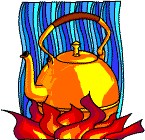Kettle
Created | Updated Jan 12, 2012

At first glance, the kettle is not a versatile piece of equipment, but it does in fact assist with a wide range of tasks such as hot drink making, cooking, shaving (when the hot water system is not working), and the filling of hot water bottles.
Basically, what a kettle does is increase the level of Brownian motion within a quantity of water. It does this by absorbing heat from either an external source, or from an internal element which gets hot when electricity is passed through it.
At this point, it should be pointed out that this Entry is referring to a standard kettle, such as you would use for making water hot, and not its many cousins eg Paint kettle, Fish kettle, Glue kettle, where the word 'kettle' just means a container.
There are many different types of kettle currently in everyday use, made of plastic or steel. These include:
- Jug kettle
- Conventional kettle
- Cordless kettle
- Whistle kettle
- Urn
Many people use the kettle on a daily basis, and yet are unaware of its ancestry. The common kettle can be traced back far into prehistory, starting from the present, auto-shutoff devices1, going back to a pot on a stove, and even before that, a pot over an open fire. As you can see, kettles in one form or another could conceivably have been used ever since the discovery of fire.
Urns are a slightly different kettle of fish (pun intended). Due to their size you can put a lot of water in them - an awful lot of water, enough to make an unbelievable number of cups of cheap instant coffee. However, due to the operational nature of these devices, (cyclic boiling, low temperature etc.) one should never under any circumstances use the water from an urn to make tea. If you do, it will taste disgusting.

